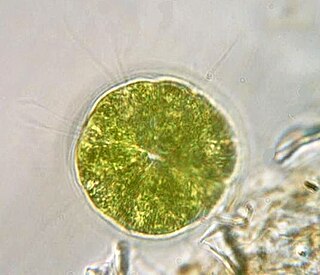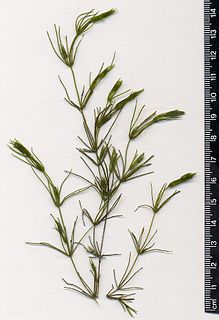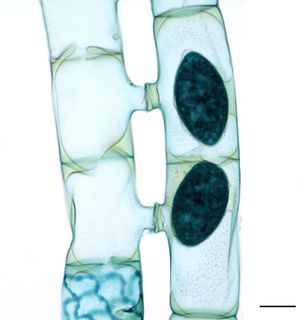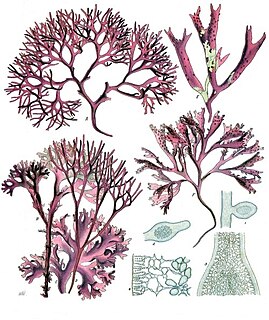
Chlorophyta or Prasinophyta is a taxon of green algae informally called chlorophytes. The name is used in two very different senses, so care is needed to determine the use by a particular author. In older classification systems, it refers to a highly paraphyletic group of all the green algae within the green plants (Viridiplantae) and thus includes about 7,000 species of mostly aquatic photosynthetic eukaryotic organisms. In newer classifications, it refers to the sister clade of the streptophytes/charophytes. The clade Streptophyta consists of the Charophyta in which the Embryophyta emerged. In this latter sense the Chlorophyta includes only about 4,300 species. About 90% of all known species live in freshwater. Like the land plants, green algae contain chlorophyll a and chlorophyll b and store food as starch in their plastids.

Desmidiales, commonly called desmids, are an order in the Charophyta, a division of green algae in which the land plants (Embryophyta) emerged. Or in other words, Desmid,, order of single-celled microscopic green algae. Desmids are sometimes treated as a family (Desmidiaceae) of the order Zygnematales.

The green algae are a large, informal grouping of algae consisting of the Chlorophyta and Charophyta/Streptophyta, which are now placed in separate divisions, together with the more basal Mesostigmatophyceae, Chlorokybophyceae and Spirotaenia.

Acetabularia is a genus of green algae in the family Polyphysaceae, Typically found in subtropical waters, Acetabularia is a single-celled organism, but gigantic in size and complex in form, making it an excellent model organism for studying cell biology. In form, the mature Acetabularia resembles the round leaves of a nasturtium, is 0.5 to 10 cm tall and has three anatomical parts: a bottom rhizoid that resembles a set of short roots; a long stalk in the middle; and a top umbrella of branches that may fuse into a cap. Unlike other giant unicellular organisms, which are multinucleate, Acetabularia has a single nucleus, located in the rhizoid and allows the cell to regenerate completely if its cap is removed. The caps of two Acetabularia may also be exchanged, even from two different species. In addition, if a piece of the stem is removed, with no access to the nucleus in the rhizoid, this isolated stem piece will also grow a new cap.

Streptophyta, informally the streptophytes, is a clade of plants. The composition of the clade varies considerably between authors, but the definition employed here includes land plants and all green algae except the Chlorophyta and the more basal Prasinodermophyta.

The Charophyta or charophytes is a group of freshwater green algae, sometimes treated as a division, but also as a superdivision, or an unranked clade. The terrestrial plants, the Embryophyta emerged within Charophyta, possibly from terrestrial unicellular charophytes, with the class Zygnematophyceae as a sister group.

Pandorina is a genus of green algae composed of 8, 16, or sometimes 32 cells, held together at their bases to form a sack globular colony surrounded by mucilage. The cells are ovoid or slightly narrowed at one end to appear keystone- or pear-shaped. Each cell has two flagella with two contractile vacuoles at their base, an eyespot, and a large cup-shaped chloroplast with at least one pyrenoid.

Viridiplantae are a clade of eukaryotic organisms that comprise approximately 450,000–500,000 species and play important roles in both terrestrial and aquatic ecosystems. They are made up of the green algae, which are primarily aquatic, and the land plants (embryophytes), which emerged from within them. Green algae traditionally excludes the land plants, rendering them a paraphyletic group. But it is accurate to think of land plants as kind of alga. Since the realization that the embryophytes emerged from within the green algae, some authors are starting to include them. They have cells with cellulose in their cell walls, and primary chloroplasts derived from endosymbiosis with cyanobacteria that contain chlorophylls a and b and lack phycobilins.

Charophyceae is a class of charophyte green algae. AlgaeBase places it in division Charophyta. Extant (living) species are placed in a single order Charales, commonly known as "stoneworts" and "brittleworts". Fossil members of the class may be placed in separate orders, e.g. Sycidiales and Trochiliscales.

The Archaeplastida are a major group of eukaryotes, comprising the photoautotrophic red algae (Rhodophyta), green algae, land plants, and the minor group glaucophytes. It also includes the non-photosynthetic lineage Rhodelphidia, a predatorial (eukaryotrophic) flagellate that is sister to the Rhodophyta, and probably the microscopic picozoans. The Archaeplastida have chloroplasts that are surrounded by two membranes, suggesting that they were acquired directly through a single endosymbiosis event by feeding on a cyanobacterium. All other groups which have chloroplasts, besides the amoeboid genus Paulinella, have chloroplasts surrounded by three or four membranes, suggesting they were acquired secondarily from red or green algae. Unlike red and green algae, glaucophytes have never been involved in secondary endosymbiosis events.

Eustigmatophytes are a small group of eukaryotic algae that includes marine, freshwater and soil-living species.

The Trebouxiophyceae are a class of green algae, in the division Chlorophyta. Their circumscription within the green algae is not well established due to the need for more genetic studies at higher levels within the group.
Ankyra is a genus of green algae in the family Characiaceae. This genus of algae is closely related to Atractomorpha and Sphaeroplea.
Dictyochloropsis is a genus of unicellular green alga of the phylum Chlorophyta. This genus consists of free-living algae which have a reticulate (net-like) chloroplast that varies slightly in morphology between species, and that when mature always lacks a pyrenoid. Dictyochloropsis is asexual and reproduces using autospores.
Golenkinia is a genus of green algae first described in 1894 by Robert Chodat. The genus is named for the Russian phycologist Mikhail Iljitsch Golenkin. Golenkinia species live in fresh water and are found around the world.
Koliella is a genus of green algae in the order Prasiolales.

Zygnematophyceae is a class of green algae in the division Charophyta, consisting of more than 4000 described species. It contains the order Zygnematales. The Desmidiales emerged within the Zygnematales. The Zygnematophyceae are the sister clade of the Mesotaenium, together forming the sister clade of the land plants. The body plan of Zygnematophyceae is simple, and appear to have gone through a secondary loss of morphological complexity. They contain genes involved in protection from desiccation that appear to have been derived by horizontal gene transfer from bacteria; the genes are found in plants, Zygnematophyceae, bacteria, but no other organisms. The genes may have helped to enable plants to make the transition to life on land.

Red algae, or Rhodophyta, are one of the oldest groups of eukaryotic algae. The Rhodophyta also comprises one of the largest phyla of algae, containing over 7,000 currently recognized species with taxonomic revisions ongoing. The majority of species (6,793) are found in the Florideophyceae (class), and mostly consist of multicellular, marine algae, including many notable seaweeds. Red algae are abundant in marine habitats but are relatively rare in freshwaters. Approximately 5% of the red algae occur in freshwater environments with greater concentrations found in warmer areas. Except for two coastal cave dwelling species in the asexual class Cyanidiophyceae, there are no terrestrial species, which may be due to an evolutionary bottleneck where the last common ancestor lost about 25% of its core genes and much of its evolutionary plasticity.

Phacus is a genus of unicellular excavates, of the phylum Euglenozoa, characterized by its flat, leaf-shaped structure, and rigid cytoskeleton known as a pellicle. These eukaryotes are mostly green in colour, and have a single flagellum that extends the length of their body. They are morphologically very flat, rigid, leaf-shaped, and contain many small discoid chloroplasts.

The Phragmoplastophyta are a proposed sister clade of the Klebsormidiaceae, with which they form the Streptophyte/Charophyte clade. The Phragmoplastophyta consist of the Charophycaea and another unnamed clade which contains the Coleochaetophyceae, Zygnematophyceae, Mesotaeniaceae, and Embryophytes. It is an important step in the emergence of land plants within the green algae. It is equivalent to the ZCC clade/grade, cladistically granting the Embryophyta.















